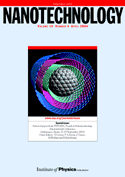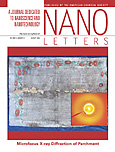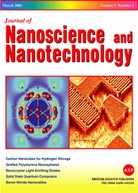
Compartilhar informações sobre duas áreas relevantes nas pesquisas atuais: Nanociência e Nanotecnologia. (Conteúdo em.../Contenido en.../Content in...Portugués/Español/English
30 de julho de 2006
Novo Jornal de acesso gratuito - Nanoscale - SPRINGER

Revistas Científicas de Nanociência e Nanotecnologia
Nanotechnology Council.
IEEE Transactions on Nanotechnology es una revista científica interdisciplinar impulsada por 18 sociedades científicas lideradas por el IEEE Council on Nanotechnology. Tomando un papel internacional destacado en la difusión del conocimiento en nanotecnología, esta revista está dedicada a los nuevos resultados, debates y a la promoción de la comprensión de la física básica y de las aplicaciones de ingeniería y los fenómenos al nivel de la nanoescala Poniendo énfasis en una multitud de disciplinas donde los efectos de la nanoescala llegan a ser importantes y únicas las propiedades observadas IEEE Transactions on Nanotechnology es un foro para la generación de ideas de interés multidisciplinar.
Editor-in-Chief: Prof. Sandip Tiwari Cornell University

Nanotechnology
Nanotechnology está dedicada a cubrir todos los aspectos de la ciencia y la tecnología a nanoescla desde una perspectiva multidisciplinar.
Editor-in-Chief M Welland, University of Cambridge, UK

Nano Letters
American Chemical Society.
Nano Letters centra su atención en la investigación básica en todas las ramas teóricas y prácticas de la nanotecnología y la nanociencia, proporcionando un rápido acceso a los elementos claves de estudio mediante la publicación de resultados de los fenómenos de la biología, la física, la química teórica y experimental experimental, junto con procesos y aplicaciones de las estructuras a nanoscala. Entre las áreas de interés que cubre esta revista tenemos: síntesis y procesamiento inorgánico y orgánico de materiales de híbridos a nanoescala por métodos físicos, químicos y biológicos con modelización y simulación de procesos de procesos de interacción y ensamblaje. Caracterización de las propiedades dependientes de la nanoescala. Realización y aplicación de estructuras y nanoaparatos innovadores.
Editor: A. Paul Alivisatos, Chancellor's Professor of Chemistry and Materials Science. College of Chemistry. University of California
Virtual Journal of Nanoscale Science and Technology
Editor: David Awschalom, Department of Physics; University of California, Santa Barbara.
Esta revista contiene artículos que han aparecido en una de las fuentes de las revistas participantes y que están dentro de alguno temas de estructuras a escala nanométrica en ciencia y tecnología. Los artículos han sido publicados la semana anterior en las referidas revistas. Sin embargo, y a discreción de los editores, los artículos más antiguos pueden también aparecer en el Journal, particularmente los referenciados.

Journal of Nanoscience and Nanotechnology
American Scientific Publishers
Journal for Nanoscience and Nanotechnology (JNN) es una revista internacional con una amplia cobertura de la actividad investigadora en todas las áreas de la nanotecnología y la nanociencia. La JNN artículos de texto completo, comunicaciones rápidas de avances y descubrimientos importantes, revistas sobre el estado de temas centrales, e investigaciones actuales teóricas y aplicadas en todas las disciplinas de la ciencia, la ingeniería y la medicina.
Editor: H. S. Nalwa, USA
Produtos eletrônicos baseados em Nanotubos de carbono chegaram aos $3.6 billões
The report, "Carbon Nanotube Electronics, A Technology Analysis and Eight-Year Market Forecast," says that the biggest near-term opportunities for "nanotube electronics" will come from the sensor, display and memory sectors. Each of these markets will include more than $200 million in CNT-based products by 2007:
- Nanotubes are already being used to produce tiny sensors, potentially capable of distinguishing a single molecule. This could make nanotubes the material of choice for the highly sensitive sensors required for medical and homeland security applications. The low power consumption of nanotube sensors also makes them ideal choice for battery-powered sensor networks.
- Nanotube-based field emission displays combine the high-quality video of CRTs with the flatness of LCD and plasma displays, but without the burn-in and poor viewing angles associated with today's flat-panel displays. Samsung will release its CNT-driven television in 2006. Other large electronics firms that are developing such displays include Hitachi, Sony, Mitsubishi and Toshiba.
- Nanotube-based memories will combine the speed of SRAM with the non- volatility of Flash, which should allow them to quickly penetrate the laptop, mobile phone and PDA markets. NanoMarkets believes this market could generate hundreds of millions of dollars in revenue.
NanoMarkets also notes that CNT-based interconnects and thermal management could help provide CMOS with a much needed enabling technology as it moves to 45-nm and 22-nm nodes. Nanotube-based logic, processors, interconnects and thermal management solutions are already the subject of intense research by IBM, Intel and NEC which believe that their work in this field will help CMOS scale to smaller feature sizes.
This report provides eight-year growth projections broken out by product type and application. These projections are based on market surveys as well as NanoMarkets' forecasting model for the emerging nanoelectronics sector. The report is designed to provide critical information for firms involved in the electronics industry and their materials and device suppliers.
Fonte:
Nanomarket
Nanotecnología para crear sistema que impide que se empañe el cristal
Fonte:
Euroresidentes
Roupa que combate as toxinas
Cientificos estão criando roupas para aplicações militares e médicas que atuan como uma barreira contra as toxinas, matam as bactérias e respiram de tal forma que permitem que o suor seja eliminado.
Isto ajudaria na resistencia a liquidos ou vapor, por exemplo médicos e enfermeiras ou solados expostos a patógenos. Essa pesquisa começou quando o professor Gang Sun, da Universidade de California Davir, inventou um método para adjuntar molêculas de polimeros com cloro a fibras texteis. Essa molêculas matam bácterias de maneira quase instantánea e ademais não causam dano na pele humana.
Fonte:
Technology Review
Euroresidentes
28 de julho de 2006
Beneficios económicos da nanotecnologia

Há duas linhas de pesquisas quando o tema é nanotecnologia: uma real, que vem sendo desenvolvida com resultados expressivos, e outra ainda futurista, que vislumbra possibilidades difíceis até mesmo de imaginar.
“Mas, no que diz respeito à transferência de conhecimento entre universidades e indústria, a nanotecnologia é uma realidade consolidada no Brasil”, disse Fernando Galembeck, professor do Instituto de Química da Universidade Estadual de Campinas (Unicamp), durante conferência na 58ª Reunião Anual da Sociedade Brasileira para o Progresso da Ciência (SBPC).
Para Galembeck, o setor químico é um dos poucos no país em que o conhecimento científico tem conseguido gerar riqueza. “Esse é um setor que gera, domina e exporta tecnologias nacionais. E grande parte desses resultados pode ser associada aos materiais nanoestruturados”, disse. Segundo ele, a indústria química brasileira hoje oscila ente a 10ª e a 12ª posição no ranking mundial de produção.
“Estima-se que só nos Estados Unidos serão gastos, até 2020, cerca de US$ 44 bilhões apenas com a produção de nanocompósitos poliméricos, sem contar outros materiais. As expectativas para o setor em todo o mundo são mais do que brilhantes, são ofuscantes”, aponta o professor da Unicamp.
O pesquisador apresentou um projeto estratégico de desenvolvimento de fibras de carbono a partir de poliacrilonitrila, uma fibra acrílica utilizada na fabricação de mantas e tapetes. Em princípio, a poliacrilonitrila utilizada pelo setor têxtil não servia para fazer fibras de carbono, “mas, graças à nanotecnologia conseguimos produzir, a partir desse material acrílico, fibras de carbono para aplicação totalmente verticalizada, ou seja, desde as matérias-primas mais simples até o produto final mais sofisticado”, disse.
As fibras de carbono são consideradas materiais estratégicos para o país. A Embraer, por exemplo, que utiliza largamente essas fibras em suas linhas de produção de aviões, precisa importar material.
“Como ainda não fazemos parte do clube dos grandes produtores mundiais de fibras de carbono, estamos criando competência nacional em vários pontos da cadeia produtiva. E iremos precisar de mais especialistas na área, que saibam trabalhar em prol do aumento da produtividade nanotecnológica”, disse Galembeck.
FAPESP
17 de julho de 2006
Toxic Effects of Carbon-Based Nanomaterials

Writing in the journal Nano Letters, a team of researchers based at the École Polytechnique Fédérale de Lausanne in Switzerland report their studies on how shape, size and surface properties affect cellular toxicity. This team, led by Arnaud Magrez, Ph.D., added increasing concentrations of multi-walled carbon nanotubes, carbon nanofibers, or carbon nanoparticles to three different types of cultured human lung tumor cells and measured changes in cell proliferation and overall cellular health. The researchers found evidence of toxicity as soon as 24 hours after dosing with all three materials and in each cell line, though multi-walled carbon nanotubes were the least toxic in all assays.
The investigators noted that they were surprised that carbon nanoparticles proved to be the most toxic of the three materials they studied, though they added that this finding suggests that “dangling bonds” could be responsible for the toxicity of carbon nanomaterials. Highly reactive dangling bonds – carbon atoms not bonded to three other carbon atoms and thus available to react with biomolecules – are more prevalent in the carbon nanoparticles tested than in either nanofibers or nanotubes.
A second paper in Nano Letters, this one written by collaborators at the Centre National de la Recherche Scientifique (CNRS) in Strasbourg, France, and the University of Trieste in Italy, presents data showing that functionalized nanotubes are not toxic at all to three major classes of immune system cells. In this study, the investigators prepared two types of nanotubes whose surfaces had been modified in order to attach various targeting or therapeutic molecules and to render them soluble in water. In this case, the modifications were used to attach fluorescent dye molecules to enable intracellular tracking.
Studies with both types of nanotubes showed that they were taken up readily by immune system cells. However, none of the immune cells showed any signs of toxicity. Additional experiments showed that the functionalized nanotubes did not affect the functional activity of these cells either. The researchers note that their results confirm the findings of other laboratories that water-soluble carbon nanotubes have limited or no toxicity when tested in a wide variety of cell types.
To better understand how cells process one type of carbon nanomaterial, a team of investigators at the University of Cambridge in the United Kingdom, used high-resolution three-dimensional electron microscopy to track where buckyballs, or C 60, travel to in cells. Using non-toxic doses of buckyballs, the investigators found that buckyballs concentrated in intracellular lysosomes, along the cell membrane, along the nuclear membrane, and within the nucleus. Finding significant numbers of the nanoparticles in these latter two locations was a surprise to the investigators. They noted that accumulation of buckyballs within the cell nucleus could lead to DNA damage.
Nanotechnology in Cancer